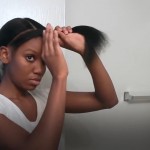Why Some Human Hair Extensions Get Frizzy and Tangled: Causes and Solutions
Human hair extensions have become an integral part of the beauty industry, providing individuals with the opportunity to achieve various hairstyles and looks. However, a common concern among those who use human hair extensions is the issue of frizziness and tangling. Understanding why this occurs and how to prevent it is essential for maintaining the longevity and appeal of hair extensions. In this article, we delve into the science of human hair, the different types of hair extensions, common causes of frizz and tangles, and, most importantly, how the quality of the hair used can make a significant difference.
The Science Behind Human Hair
To understand why some human hair extensions become frizzy and tangled, it’s crucial to grasp the fundamental structure of human hair. Human hair consists of three main layers: the medulla, cortex, and the cuticle. The outermost layer, the cuticle, is a protective layer composed of overlapping, scale-like cells. This cuticle layer plays a vital role in determining the quality and behavior of hair.

When hair is healthy and well-maintained, the cuticle layer lies flat, protecting the inner layers from damage and sealing in moisture. The smoother and more intact the cuticle layer is, the less likely the hair is to tangle and become frizzy. Therefore, the condition of the cuticle layer is central to the overall quality of the hair.
The Types of Human Hair Extensions
Human hair extensions come in various forms, and the type you choose can significantly impact how prone they are to frizz and tangles. The primary categorizations are natural (human) hair extensions and synthetic hair extensions. Within the realm of natural hair extensions, there are various factors to consider, such as hair texture and processing methods.
Natural hair extensions, as the name suggests, are made from real human hair, which allows for a more natural appearance and greater versatility in styling. On the other hand, synthetic extensions are made from artificial materials and tend to be less susceptible to frizz and tangling but lack the natural look and feel of human hair.
When considering natural hair extensions, it’s essential to take hair texture into account. Human hair can be straight, wavy, curly, or kinky, with each texture having its unique properties. While straight hair may be less prone to tangling, curly and kinky hair extensions require more care and attention to maintain their appearance.
Processing methods also play a role in determining the quality of hair extensions. Remy extensions, for example, are considered higher quality because they are made from hair collected with the cuticles aligned in the same direction, which minimizes tangling. Non-Remy extensions, on the other hand, often have their cuticles stripped or misaligned, making them more prone to frizz and tangling.
Common Causes of Frizziness and Tangling
Frizzy and tangled hair extensions can be attributed to several factors, many of which can be managed with proper care and attention. These factors can be broadly categorized into three main areas: lack of proper care and maintenance, environmental influences, and the quality of the hair extension.
1. Lack of Proper Care and Maintenance
One of the most significant contributors to frizz and tangles in hair extensions is the lack of appropriate care and maintenance. Just like natural hair, extensions require regular attention to remain in good condition.
- Shampoo and conditioning: Using the wrong hair care products or failing to wash and condition hair extensions regularly can lead to a build-up of oils and residue, making the hair look dull and lifeless. The lack of moisture can result in increased frizziness and tangling.
- Heat styling and over-processing: Excessive heat styling or chemical treatments can damage the cuticle layer of the hair, causing it to lose its smoothness and leading to frizz. Proper heat protectants and limiting these processes can help maintain the hair’s quality.
2. Environmental Factors
Environmental influences can also have a significant impact on the condition of hair extensions, especially in terms of frizz and tangling.
- Humidity: High humidity levels can cause hair extensions to absorb moisture from the air, leading to swelling and increased frizziness. Proper sealing products can help protect hair in humid conditions.
- Pollution: Exposure to environmental pollutants can lead to a build-up on the hair, making it more prone to tangling and frizz. Regular cleaning and protection are essential.
3. Quality of the Hair Extension
Perhaps the most crucial factor influencing the frizziness and tangling of human hair extensions is the quality of the hair itself. As mentioned earlier, Remy extensions, with their aligned cuticles, are less likely to tangle and frizz compared to non-Remy extensions, which often have misaligned or stripped cuticles. Virgin hair, which has not undergone chemical processing, tends to be of higher quality and less prone to frizz and tangling than non-virgin hair.
Investing in high-quality hair extensions is, therefore, crucial to minimize the risk of frizz and tangling, and to ensure that your extensions remain in excellent condition for an extended period.
Preventive Measures
While frizz and tangling can be common issues with hair extensions, there are several preventive measures that can help maintain the quality of the extensions and minimize these problems.
- Proper washing and conditioning techniques: Use sulfate-free, hydrating shampoos and conditioners, and always follow the recommended care instructions for your specific extensions.
- Choosing the right products: Invest in hair care products specifically designed for extensions, and avoid those containing alcohol or harsh chemicals that can strip the hair’s cuticle layer.
- Protective styling: Avoid styles that put excessive strain on your extensions, such as tight braids or ponytails, as these can lead to tangling. Opt for looser, more protective styles.
- Reducing exposure to environmental factors: Use hair serums and protective sprays to shield your extensions from humidity and pollution, and cover them when necessary, such as when swimming or in extreme weather conditions.
Remedies for Frizzy and Tangled Hair Extensions
In cases where frizziness and tangling have already occurred, there are remedies that can help restore the extensions to their former glory.
- Detangling methods: Gently use a wide-tooth comb or a soft-bristle brush to remove tangles. Start from the tips and work your way up, being careful not to pull or break the hair.
- Deep conditioning treatments: Apply deep conditioning masks or treatments to restore moisture and repair damaged cuticles. Leave-in conditioners can also help in keeping the hair smooth.
- Heat styling tips: When using heat styling tools, always use a heat protectant to shield the hair from damage. Additionally, avoid using excessive heat, as this can cause further frizz.
- Hair extension repairs: If your extensions are severely damaged, it may be worth considering professional repairs or replacement to ensure their quality and longevity.
Maintenance and Care Tips
Maintaining the quality of your hair extensions requires a consistent and thoughtful approach to care and maintenance.
- Regular maintenance routines: Create a routine that includes washing, conditioning, and detangling your hair extensions as needed, but be careful not to overdo it, as excessive washing can strip the hair’s natural oils.
- Protective storage: When not in use, store your extensions in a cool, dry place, ideally in a silk or satin bag to prevent friction and minimize tangling.
- Tips for preserving hair extension quality: Be mindful of how you treat your extensions. Avoid sleeping with wet hair, as it can lead to tangling, and be gentle when handling and styling them.
When to Seek Professional Help
While proper care and maintenance can go a long way in preventing and addressing frizz and tangling in human hair extensions, there may come a point where professional assistance is necessary. If you notice signs of irreversible damage, such as extensive breakage, thinning, or severe matting, it’s advisable to consult with a stylist or hair professional who specializes in hair extensions. They can offer tailored advice and solutions to help salvage your extensions or recommend replacements.
Conclusion
Frizzy and tangled hair extensions can be a frustrating experience, but with the right knowledge and care, these issues can be minimized or prevented. The quality of the hair extension, including factors like cuticle alignment, virginity, and processing, plays a pivotal role in how susceptible the extensions are to frizz and tangling. Investing in high-quality extensions is a worthwhile step in ensuring that your hair remains lustrous and manageable. By following proper care and maintenance routines and taking precautions against environmental influences, you can enjoy the beauty and versatility of human hair extensions for an extended period without the nuisance of frizz and tangling.











